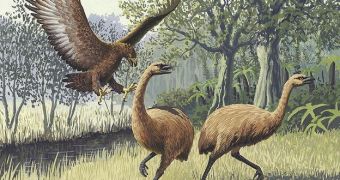Scientists have recently made a very important discovery, when they found a treasure trove of excellently preserved DNA, which they say they could use for a variety of purposes. But undoubtedly, the most important is sequencing the genome of the ancient moa birds, animals that went extinct some time ago, and that are now known only through reconstructions. It's not at all uncommon, experts say, for archaeologists to find eggshells at dig sites around the world. But lately, scientists have dramatically improved on their ability to extract genetic material from these remains, which finally led to the new achievement, Nature News reports.
The reason why the new team was so successful in acquiring more DNA material from their eggshells was because they changed the existing approach on how to do this. Until now, experts simply used a special solution to remove calcium salts from the eggshells. But the thing is that most of the eggshell, about 97 percent, is made up of the stuff. This led researchers from the Murdoch University in Perth, Western Australia, to wonder whether decalcifying the samples was indeed the best course of action. The group was led by evolutionary biologist Michael Bunce, who collaborated with graduate student Charlotte Oskam.
The team began looking for DNA samples in both the solution used to remove the calcium from the fossils, as well as in the powder that was obtained following this process. Group members managed to find important amounts of genetic materials in the solution, but were taken aback by the fact that the powder they were actually supposed to analyze had very little traces of DNA. This led them to conclude that most of the studies on eggshells conducted thus far have been throwing out precious amounts of ancient DNA. “This is a quite exciting piece of work. It is rather embarrassing for the ancient-DNA community that we have not tried this before,” University of York biologist Michi Hofreiter.
“Collecting ancient DNA is a numbers game and our job gets a whole lot easier if we can maximize DNA yields,” Bunce reveals. He and his graduate student also learned that the eggshells relaxed their calcium matrix when heated to a temperature of about 95 degrees Celsius for 10 minutes. This allowed the experts to extract twice as much DNA as previously thought possible. The innovation in genetic material extraction will most likely be employed in other fields of research that deal with carbonated fossils.

 14 DAY TRIAL //
14 DAY TRIAL //